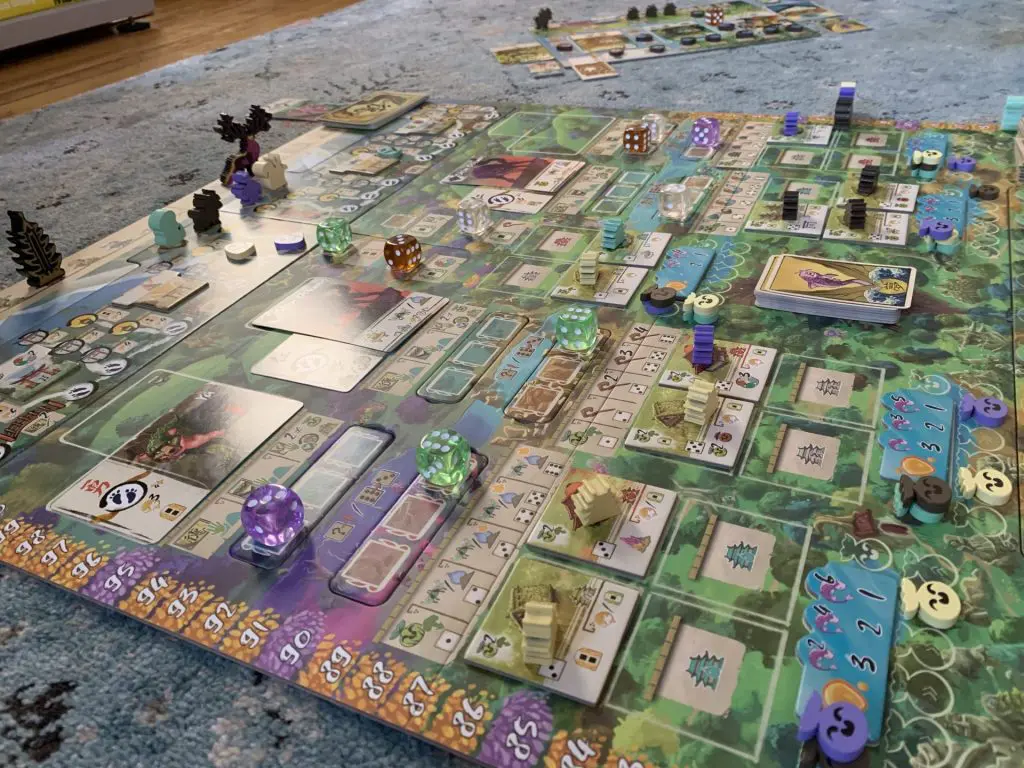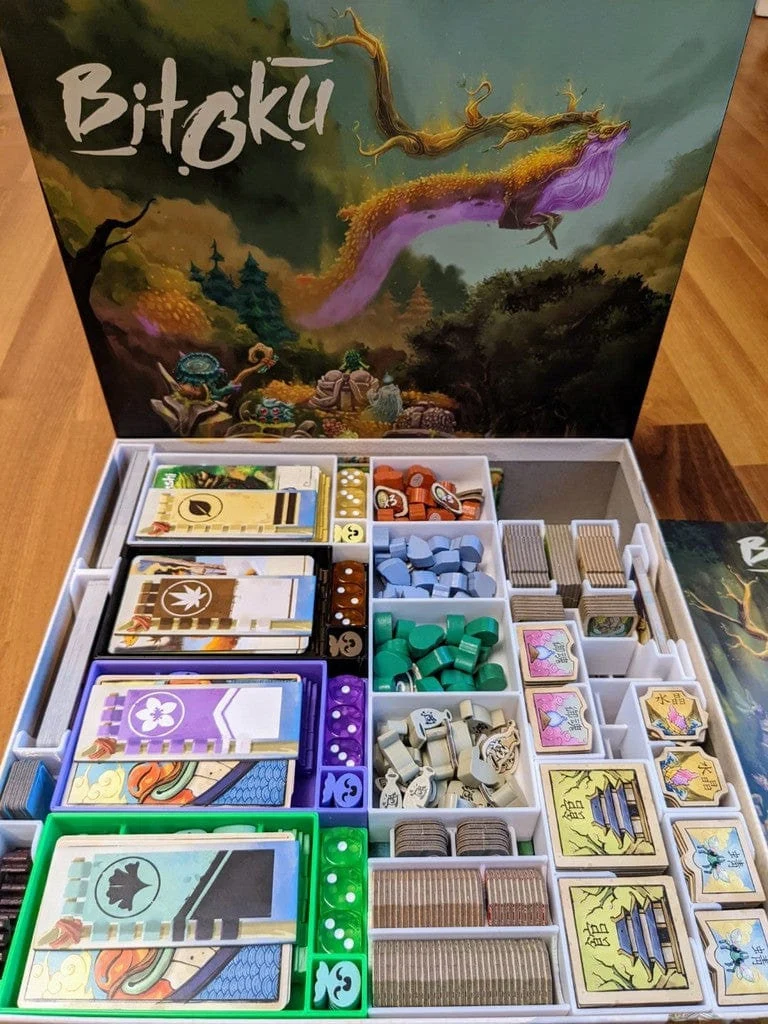Bitoku Board Game Review
Looking at Bitoku, you would be forgiven if you thought you were in for one of the most complicated games of your life. While on the surface this appears to be true, once you’ve learned the turn-by-turn structure of the game, things begin to flow really well and then it’s just about decisions, as opposed to wondering what might happen if you do x, y or z.
Bitoku still isn’t a light game, and is probably bordering on that heavy category, but it’s a game worth playing if you love cascading benefits – i.e. you do something it and gets you this, that, and everything in between.
We recently did a components overview and review of Bitoku, and you can read that here. One element I want to discuss here is a pretty big negative in my opinion. Bitoku takes up a lot of space, and is very busy. This is a table hog, and if you plan to play with four players, you are going to need a substantial area to play the game.
This is particularly tough for our group playing on 3×5 tables – we had to put things off to the side on other tables just to get this played. Further to the space this game takes, it’s also very busy. You will have bits and bobs all over the place, from the paths you are creating off your player board, to your deck piles, token piles, and of course, the massive game board in the middle of the table.
https://youtu.be/bZh0hYH0tH0?si=3JfMR1sjcUnvFbG-
Check out the official DEVIR How to Play video to get a better understanding of how Bitoku works!
And let’s talk about that – this board is absolutely gorgeous, and in almost every situation I would say gorgeous artwork is a major plus for any board game. This artwork, in my opinion, gets in the way of LEARNING the game. Why? It’s beautiful, but it is super busy.
There is stuff everywhere on this board, and while there are nicely outlined spaces for where your dice go when playing them, it’s still very busy and a bit overwhelming. Note, I said this was a problem when learning the game, and that is true. However, I set that expectation because once you DO know how everything works, and where everything goes, the busyness of the board becomes a much, MUCH smaller problem.
After all of that, though, I’m here to say that Bitoku is a phenomenal board game experience. This is a nice, deep, chunky game. Lots of decisions to make, lots of things to think about, lots of ways to score points. For some, this type of sprawling game won’t be their cup of tea, and that is perfectly fine. In fact, I’d argue that this generally insn’t my kind of game either. However, it’s addicting to get stuff turn after turn. Play a Yo-Kai card, unlock a dice. Place a die, get some benefits. Move the die across the river, get even more benefits. Oh ya, and while you do all those actions, you’ll probably start chaining other benefits as well, getting goods, cards, and more.
At the simplest, that is all there is to know for Bitoku. Play a card, unlock a die. Place a die on the board in any available slot. Move a die across the river to another slot. That’s it. Those are your actions. Now of course, it’s more complicated than that, but once you learn that is what you get to do each turn, it makes understanding how Bitoku works so much easier.
And the way Bitoku works is balancing your decisions on which points you want to go for. Want points for moving up paths? Focus on paths. Want points from firefly tiles? Want points from stones? Want points for cards? There are a ton of different ways to get points, and I felt that in the early game, deciding where to go and what to do was a bit daunting. But as you play, I found my strategy for each game ultimately unraveled before me. As other players do specific things, or you find specific resources in your pile, you’ll be pushed in a few different directions. Do you focus on all the ways to earn points? Do you get uber specialized in one or two ways? There is a lot.
Honestly, though, I found that Bitoku played best as a two player game. There will be less places on the board to do things, but I think less people is more forgiving. In our larger player count games, we found one player always seemed to get left behind, which can be a bit deflating for a game of this length. This is also a hard game to play if not everyone at the table is familiar with the mechanics. This is a game you play more than a few times to simply understand strategies. It’s not something many will pick up and be instantly good at.
And truthfully, less people makes the game faster as well, which is another potential downside if you are looking to play multiple games in one evening.
This is, however, a really rewarding experience. Rewarding if you lose, in my opinion, and even more rewarding as you win. I feel like after my first game of Bitoku I had conquered something difficult, and I enjoyed every minute of it despite the loss. This is a great experience, with tons of content packed into a relatively small box comparatively. And I wouldn’t let it leave my collection at the moment for anything. That’s high praise, as we have dozens of games per month coming into the office. That means nearly as many need to leave as well. This is staying.
Take that as you will.


